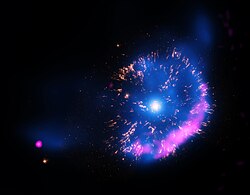GK Persei
Appearance
| Observation data J2000.0
| ||
|---|---|---|
| Constellation | Perseus | |
| Right ascension | 03h 31m 11.82s[1] | |
| Declination | +43° 54′ 16.8″[1] | |
| Apparent magnitude (V) | 0.02[2] - 14.0[3] | |
| Characteristics | ||
| Spectral type | K1IV[4] | |
| Absolute magnitude (MV) | −9.1 - +3.7[2] | |
Inclination (i) | 67 ± 5° | |
| Semi-amplitude (K2) (secondary) | 126.4 ± 0.9 km/s | |
| Details[7] | ||
| White dwarf | ||
| Mass | 1.03+0.16 −0.11 M☉ | |
| Subgiant | ||
| Mass | 0.39+0.07 −0.06 M☉ | |
| Radius | 2.26 ± 0.11 R☉ | |
| Database references | ||
| SIMBAD | data | |
GK Persei (also Nova Persei 1901) was a bright
cataclysmic variable
star.
Surrounding GK Persei is the Firework Nebula, a nova remnant first detected in 1902 consisting of an expanding cloud of gas and dust bubbles moving up to 1200 km/s.[11]
AAVSO
data. The main plot shows the major outburst in 1901. Subplot A shows the minor outbursts which have been occurring about every 3 years since around 1980. Subplot B shows the outburst that occurred in 2018, on an expanded scale.GK Persei has precise parallaxes reported from
Gaia EDR3,[12][6] but these are thought to be badly affected by the binary nature of the system. The Hubble Space Telescope has used a different method to derive the distance to GK Persei using nebular expansion velocity and compares that with its own astrometric parallax calculation. This gave a somewhat smaller parallax (larger distance) than the Gaia measurements.[13]
Properties
Novae consist of a main-sequence to giant star that accretes mass onto a white dwarf. The two stars of GK Persei orbit each other with a period of nearly 2 days. The white dwarf, with a mass of 1.03 M☉, has one of the highest masses measured in a cataclysmic variable. The donor star, having donated much of its mass to the white dwarf, is only 0.39 M☉ despite being a subgiant star.[7]
Gallery
-
The location of GK Persei (circled in red)
-
GK Persei by the 32-inch Schulman Telescope at the Mt. Lemmon Observatory.
-
Expanding Nebula around GK Persei. Images range from 1953 to 2012.
-
Changing light-echo observed at the time of the 1901 Nova, hand-drawn by G.W. Ritchey at the Yerkes Observatory.
References
- ^ S2CID 120396435
- ^ S2CID 118925493.
- Bibcode:1995gcts.book.....V.
- .
- Bibcode:1953GCRV..C......0W. Retrieved 25 January 2021.
- ^ .
- ^ .
- ^ "V* GK Per". SIMBAD. Centre de données astronomiques de Strasbourg. Retrieved 28 December 2016.
- Bibcode:2013JBAA..123..270S.
- .
- ^ "NOAO". Archived from the original on 28 May 2010. Retrieved 22 June 2008.
- .
- S2CID 118376206.





